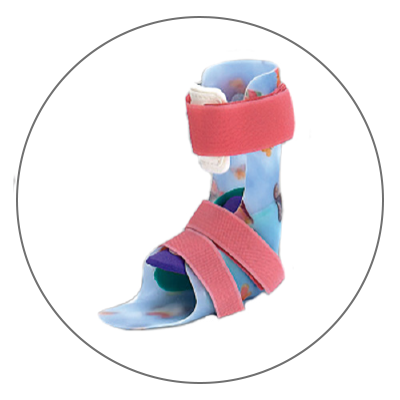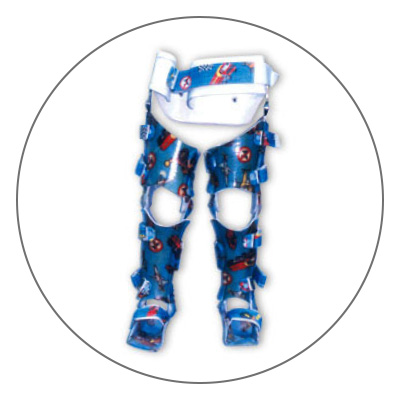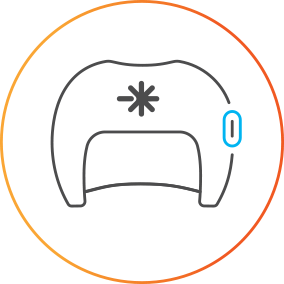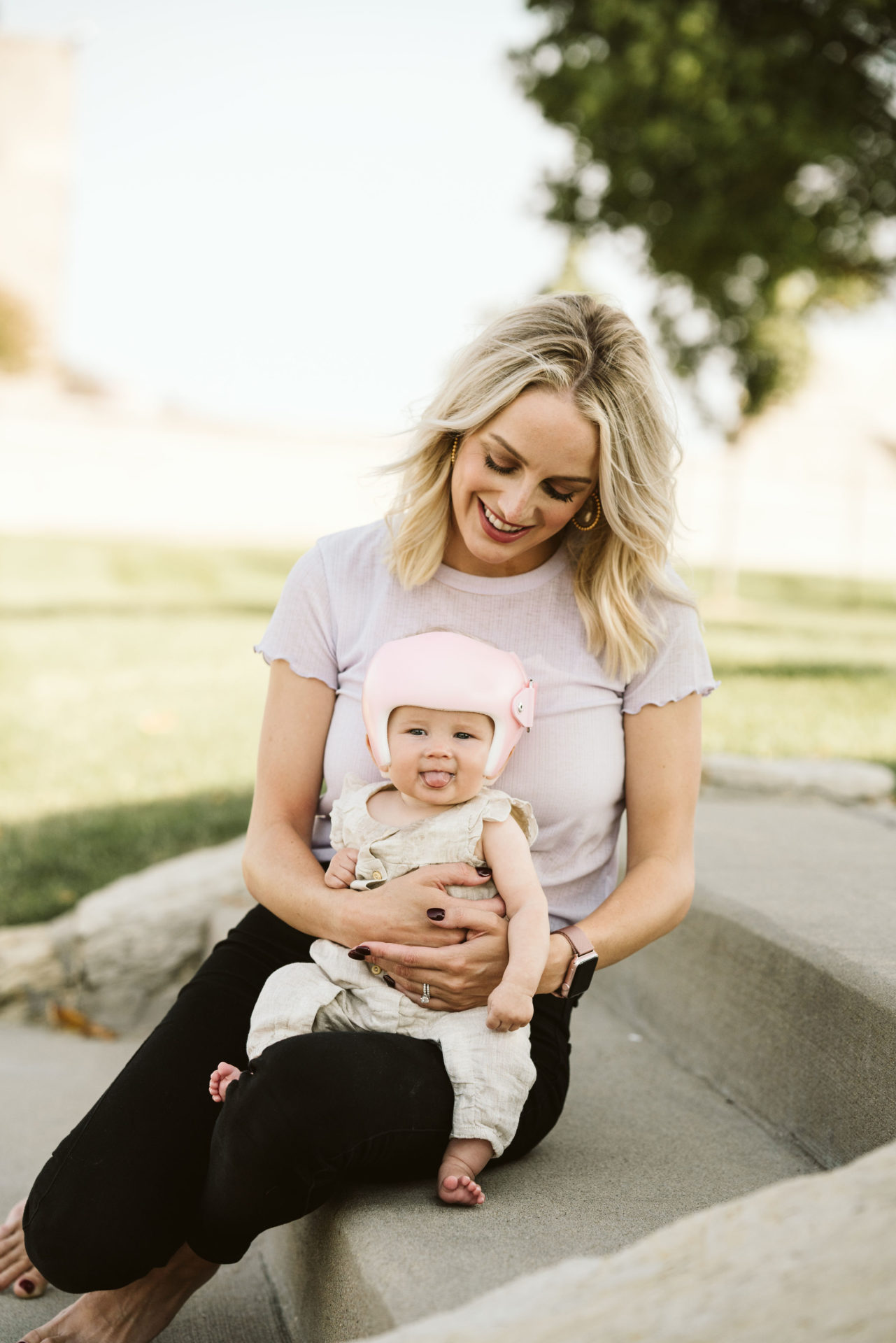The Goal of Scoliosis Bracing: Stop Progression of the Curve
The primary goal of the brace is to stop the progression of the curve. For example, if your child starts with a 27-degree curve, the goal is to keep the curve at 27 degrees and for it not to get worse over the course of treatment.
Types of Bracing
There are many different types and manufacturers of scoliosis braces available. The type of brace will be determined by the spine doctor and your child’s orthotist (the clinician who fits the brace).
Typically, the braces are plastic on the outside, and the majority are lined on the inside with foam (although the foam lining is optional to allow for a thinner aesthetic). Different color patterns are available for children who want to personalize their brace.

Treatment Timeline
Typical treatment timelines range from 1-3 years, with the most common timeframe being about 2 years. Since the timeline is usually quite long, brace compliance is key.
In this case, compliance means wearing the brace for the number of hours indicated by your spine doctor and orthotist. The orthotist will work with your family to determine what is realistic in terms of wear time (taking into account sports, dance, activities, after-school commitments, etc.), so they can build a plan accordingly.
Full-time vs. Nighttime Bracing
The referring physician will make the decision as to whether your child needs to be in a full-time brace or a nighttime brace based on several different factors (bone age, chronological age, onset of menstrual cycle [in females], and curve magnitude).
The recommendation for full-time bracing is to wear the brace 16-20 hours a day, and the recommendation for nighttime bracing is to wear the brace 8-10 hours every night.
Studies show that full-time bracing worn for greater than 17 hours had a much higher success rate of preventing the progression of the curve than in patients who wore their braces for less than 17 hours. This reinforces the importance of brace compliance and ensuring the brace is being worn as prescribed.1
It is also important to note that the nighttime brace will maximize the in-brace correction for fewer hours each day. The decision between full-time bracing and nighttime bracing is often discussed with the spine doctor, orthotist, patient, and family.
Depending on the child’s growth, full-time braces last about 12 months and nighttime braces last anywhere from 18-20 months. Some children may require more than one brace over the course of treatment.

The Hanger Clinic Difference
Our team of expert clinicians established Clinical Practice Guidelines for treating adolescent idiopathic scoliosis based upon 2016 SOSORT International Society on Scoliosis Orthopedic and Rehab Treatment consensus findings.
These guidelines serve as the standard of care at Hanger Clinic and include five different areas that help ensure Hanger Clinic clinicians treating scoliosis patients have the necessary experience and education to provide the best possible care and outcomes.
The Clinical Practice Guidelines include seven different biomechanical design considerations to ensure all braces provided through Hanger Clinic are fabricated to a specific, high-quality standard.
Our Approach to Care
Our approach centers on communicating with families, partnering with broader healthcare teams, incorporating age-appropriate treatment plans, and applying new, innovative technologies throughout each child’s journey to ensure the best possible care today and into the future.


Request a Free Evaluation
Want an expert opinion as to whether your child will benefit from a scoliosis brace? Schedule a free evaluation with a Hanger Clinic Pediatric Specialist.
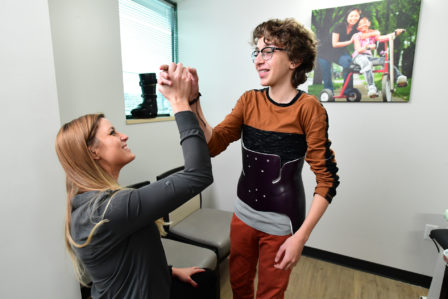
What to Expect on the Scoliosis Treatment Journey

The diagnosis is usually made by your child’s pediatrician or spine doctor, and the appropriate course of treatment is recommended.

If your child’s curve is between 25-50 degrees, bracing will likely be prescribed and the referring physician will decide whether he or she needs a full-time brace or a nighttime brace. Your family will receive a prescription for the brace and will be referred to an orthotic provider, such as Hanger Clinic.

At the first appointment (which typically takes 60-90 minutes), your orthotist will evaluate and measure your child for the brace indicated on the prescription. The evaluation consists of a clinical postural assessment looking at the shoulders, scapula, waist, and hips, as well as taking measurements and looking at your child’s X-rays.
Measurements are typically taken either standing or laying down, and sometimes a scan is taken, so the orthotist can capture the shape of your child. At the same time measurements are being completed or within 48 hours of the appointment, the office staff will work to verify insurance coverage, with the goal of providing families with an understanding of their out-of-pocket costs (due to their deductible and coinsurance).

Your orthotist will send the measurements and scans (if applicable) to a design center where the brace will be fabricated.

Within 2-4 weeks of the initial evaluation, your family will return to the clinic for fit and delivery (this appointment typically lasts 45-90 minutes). At that time, your orthotist will evaluate and adjust the brace to ensure a comfortable fit and the proper function. They will review the break-in schedule and cleaning instructions, show the parent and patient how to take the brace on and off, and will schedule necessary follow-up appointments.

It usually takes 1-2 weeks for children to get used to wearing the brace, which is why orthotists allow for a gradual break-in schedule. While there may be areas of redness that correspond with areas of pressure from the brace, there shouldn’t be areas of skin irritation associated with the bracing. The orthotist will advise on how to best address red pressure areas based on your child’s individual case.

Your family will return 2-10 weeks following delivery for a follow up appointment, which could be with your spine doctor and / or orthotist. The timing and who is at this appointment depends on your spine doctor’s protocols. At this appointment, an in -brace X-ray may be taken. If necessary adjustments are required, an additional appointment with your orthotist may be scheduled.
Your orthotist will also take the time to answer questions, discuss concerns, and review wear time compliance. Compliance monitors may be installed in the brace, allowing the orthotist to print and review wear time reports with families, and celebrate your child’s accomplishments.

The next follow-up appointment will be with your referring physician 4-6 months after the initial prescription was written. Your child will continue to see their physician for follow-up appointments every 4-6 months throughout the course of treatment or as determined by your spine doctor.

Intermittently between the visits with your referring physician, you will see the orthotist for adjustments to accommodate for growth (typically every 3-6 months, depending on the type of brace and upon the discretion of the orthotist). Patient and families are encouraged to call if adjustments are necessary before the next scheduled appointment.

The referring spine doctor will determine when bracing is discontinued. This is typically at skeletal maturity.
Insurance Coverage for Scoliosis Bracing
Scoliosis braces (TLSOs) are a covered benefit under many insurance plans. Hanger Clinic is in-network with more than 2,500 insurance providers, helping you receive your covered benefit under your insurance plan.
Our experienced office staff will verify your benefits with your insurance carrier to determine the amount of coverage available and will provide you with an estimate of your portion of the costs prior to you moving forward with treatment.
Please note–a prescription is required.

Scoliosis Brace (TLSO) Wear & Care Guide
These instructions will help you correctly use and care for your scoliosis brace. You will also be provided with guidance on a typical wearing schedule, treatment plan, and follow-up appointment schedule.
Download the Guide



